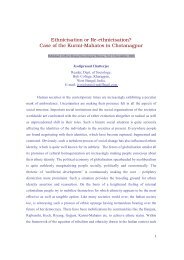Chapter 5 - WebRing
Chapter 5 - WebRing
Chapter 5 - WebRing
Create successful ePaper yourself
Turn your PDF publications into a flip-book with our unique Google optimized e-Paper software.
CHAPTER 5. MAGNETIC SYSTEMS 277<br />
where q is the number of nearest neighbor sites of a given site; q = 2 for one dimension and q = 4<br />
for a square lattice.<br />
To make this procedure explicit, consider an Ising chain with toroidal boundary conditions<br />
for N = 3. For this case p = 3(2)/2 = 3, and there are three factors in the product in (5.151):<br />
(1+vs1s2)(1+vs2s3)(1+vs3s1). We can expand this product in powers of v to obtain the 2 p = 8<br />
terms in the partition function:<br />
ZN=3 = (coshβJ) 3<br />
1<br />
1<br />
1<br />
s1=−1 s2=−1 s3=−1<br />
1+v(s1s2 +s2s3 +s3s1)<br />
+v 2 (s1s2s2s3 +s1s2s3s1 +s2s3s3s1)+v 3 s1s2s2s3s3s1<br />
. (5.153)<br />
It is convenient to introduce a one-to-one correspondence between each of the eight terms in<br />
the brackets in (5.153) and a diagram. The set of eight diagrams is shown in Figure 5.20. Because<br />
v enters into the product in (5.153) as vsisj, a diagram of order v n has n v-bonds. We can use the<br />
topology of the diagrams to help us to keep track of the terms in (5.153). The term of order v 0 is<br />
2 N=3 = 8. Because <br />
si=±1 si = 0, each of the terms of order v vanishes. Similarly, each of the<br />
three terms of order v 2 contains at least one of the spin variables raised to an odd power so that<br />
these terms also vanish. For example, s1s2s2s3 = s1s3, and both s1 and s3 enter to first-order. In<br />
general, we have<br />
1<br />
si=−1<br />
si n =<br />
<br />
2 n even,<br />
0 n odd.<br />
From (5.154) we see that only terms of order v 0 and v 3 contribute so that<br />
(5.154)<br />
ZN=3 = cosh 3 βJ[8+8v 3 ] = 2 3 (cosh 3 βJ +sinh 3 βJ). (5.155)<br />
We can now generalize our analysis to arbitrary N. We have observed that the diagrams that<br />
correspond to nonvanishing terms in Z are those that have an even number of bonds from each<br />
vertex; these diagrams are called closed. A bond from site i corresponds to a product of the form<br />
sisj. An even number of bonds from site i implies that si raised to an even power enters into<br />
the sum in (5.151). Hence, only diagrams with an even number of bonds from each vertex yield a<br />
nonzero contribution to ZN.<br />
For the Ising chain only two bonds can come from a given site. Hence, although there are<br />
2 N diagrams for a Ising chain of N spins with toroidal boundary conditions, only the diagrams of<br />
order v 0 (with no bonds) and of order v N contribute to ZN. We conclude that<br />
ZN = (coshβJ) N [2 N +2 N v N ]. (5.156)<br />
Problem 5.26. The form of ZN in (5.156) is not the same as the form of ZN given in (5.39). Use<br />
the fact that v < 1 and take the thermodynamic limit N → ∞ to show the equivalence of the two<br />
results for ZN.<br />
Problem 5.27. High temperature expansion for four spins<br />
Draw the diagrams that correspond to the nonvanishing terms in the high temperature expansion<br />
of the partition function for the N = 4 Ising chain.

















